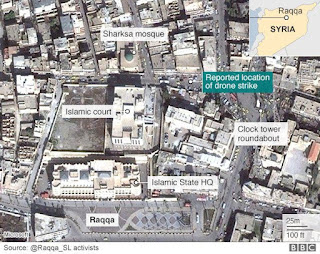The Pentagon says it is "reasonably certain" that a US drone strike in Syria has killed the Islamic State militant known as "Jihadi John".
Col Steve Warren said Thursday's attack in Raqqa had hit the intended target, but it would take time to "formally declare that we have had success".
Mohammed Emwazi, a Kuwaiti-born British militant, appeared in videos of the beheadings of Western hostages.
UK PM David Cameron said targeting Emwazi was "the right thing to do".
It is believed there was one other person in the vehicle targeted in the strike.
Col Warren said such "routine" attacks had killed on average "one mid- to upper-level IS leader every two days" since May.
However, the death of Emwazi would be a "significant blow" to IS, even though he had not been an "operational or major figure" for IS.
Who is Mohammed Emwazi?
'Jihadi John' movement mapped
Emwazi 'claimed harassment'
Separately, Turkish officials in Istanbul say they have detained a British man, believed to be Aine Lesley Davis, an alleged accomplice to "Jihadi John". Aine Davis is believed to have been guarding foreign prisoners in Syria.
'Strike at IS heart'
Speaking outside Downing Street, Mr Cameron said it was not certain whether the strike was successful, but the UK had been working with the US "literally around the clock" to track Emwazi down.
He said any successful attack would have been "a strike at the heart" of Islamic State (IS), and would demonstrate to those who would harm Britain that "we have a long reach, we have unwavering determination and we never forget about our citizens".
Three drones - one British and two American - were involved in the strike. One of the American drones hit the militants' car.
Who are Britain's jihadists?
How do you verify a militant's death?
Emwazi appeared in beheading videos of victims including British aid worker David Haines and taxi driver Alan Henning.
Mr Haines's daughter Bethany said she felt an "instant sense of relief" upon hearing reports of Emwazi's possible death, "knowing he wouldn't appear in anymore horrific videos."
"He was only a pawn in Isis's stupid game, but knowing it's over, that he's finally dead, still hasn't sunk in," she said in a statement.
"As much as I wanted him dead I also wanted answers as to why he did it, why my dad, how did it make a difference?"
'Mixed feelings'
The Henning family were informed on Thursday night by a government contact that the strike had taken place, the BBC understands.
Stuart Henning, Mr Henning's nephew, wrote on Twitter: "Mixed feelings today wanted the coward behind the mask to suffer the way Alan and his friends did but also glad it's been destroyed."
Labour leader Jeremy Corbyn said it appeared Emwazi had been "held to account for his callous and brutal crimes".
"However, it would have been far better for us all if he had been held to account in a court of law," he said.
Analysis: Frank Gardner, BBC security correspondent
After his identity was revealed in February, Emwazi largely stayed out of sight, taking particular care not to leave a digital trail to his whereabouts.
But GCHQ, the UK government's communications headquarters, has expended enormous efforts to intercept and decipher any encrypted messages that might reveal his location or those of his associates.
Emwazi is believed to have travelled to Syria in 2013 and later joined IS militants.
He first appeared in a video in August last year, when footage was posted online showing the murder of US journalist James Foley.
He later appeared in videos of the beheadings of US journalist Steven Sotloff,Mr Haines, Mr Henning, as well as American aid worker Abdul-Rahman Kassig, also known as Peter, and Japanese journalist Kenji Goto.
He was also seen apparently killing a Syrian soldier during a mass beheading of Syrian troops.
In each of the videos, the militant appeared dressed in a black robe with a black balaclava covering his face.
Art and Shirley Sotloff, the parents of Steven Sotloff, said news of his killing did not change anything - their son was not coming back and "it's too little too late".
They said it was time to remember all those who had suffered at the hands of IS.
Kenji Goto's mother, Junko Ishido, said: "I only wish there will be no more conflicts like these in this world, as my son had hoped to see peace prevail around the world."
Initially dubbed "Jihadi John" by the media, he was subsequently named as Emwazi, from west London, in February.
Advocacy group Cage, which previously suggested MI5 harassment may have contributed to Emwazi's radicalisation, said he "should have been tried as a war criminal".
Mohammed Emwazi
- 1988: Born in Kuwait, moves to UK in 1994 aged six
- Educated at the Quintin Kynaston Community Academy in St John's Wood, north London
- Fluent in Arabic and English and a British citizen
- 2009: Completes computing degree at University of Westminster, travels to Tanzania, Amsterdam and Kuwait
- 2013: Tries to travel to Kuwait but is stopped. Disappears. Parents report him missing. Police tell family four months later he has entered Syria
Source: Cage, London-based campaign group,http://www.bbc.com/news/uk-34805924
Civil war erupted in Syria four years ago, and now President Bashar al-Assad's government, IS, an array of Syrian rebels and Kurdish fighters all hold territory. Millions have been displaced and more than 250,000 people killed as a result of the fighting.
At least 700 people from the UK have travelled to support or fight for jihadist organisations in Syria and Iraq, British police say.

No comments:
Post a Comment